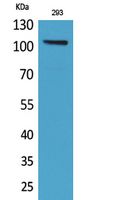Neuropilin Polyclonal Antibody
- Catalog No.:YT5452
- Applications:WB;IHC;IF;ELISA
- Reactivity:Human;Mouse;Rat
- Target:
- Neuropilin
- Fields:
- >>Axon guidance;>>Human T-cell leukemia virus 1 infection;>>Coronavirus disease - COVID-19
- Gene Name:
- NRP1
- Protein Name:
- Neuropilin-1
- Human Gene Id:
- 8829
- Human Swiss Prot No:
- O14786
- Mouse Gene Id:
- 18186
- Mouse Swiss Prot No:
- P97333
- Rat Gene Id:
- 246331
- Rat Swiss Prot No:
- Q9QWJ9
- Immunogen:
- The antiserum was produced against synthesized peptide derived from the Internal region of human NRP1. AA range:321-370
- Specificity:
- Neuropilin Polyclonal Antibody detects endogenous levels of Neuropilin protein.
- Formulation:
- Liquid in PBS containing 50% glycerol, 0.5% BSA and 0.02% sodium azide.
- Source:
- Polyclonal, Rabbit,IgG
- Dilution:
- WB 1:500 - 1:2000. IHC: 1:100-1:300. ELISA: 1:20000.. IF 1:50-200
- Purification:
- The antibody was affinity-purified from rabbit antiserum by affinity-chromatography using epitope-specific immunogen.
- Concentration:
- 1 mg/ml
- Storage Stability:
- -15°C to -25°C/1 year(Do not lower than -25°C)
- Other Name:
- NRP1;NRP;VEGF165R;Neuropilin-1;Vascular endothelial cell growth factor 165 receptor;CD304
- Observed Band(KD):
- 100kD
- Background:
- This gene encodes one of two neuropilins, which contain specific protein domains which allow them to participate in several different types of signaling pathways that control cell migration. Neuropilins contain a large N-terminal extracellular domain, made up of complement-binding, coagulation factor V/VIII, and meprin domains. These proteins also contains a short membrane-spanning domain and a small cytoplasmic domain. Neuropilins bind many ligands and various types of co-receptors; they affect cell survival, migration, and attraction. Some of the ligands and co-receptors bound by neuropilins are vascular endothelial growth factor (VEGF) and semaphorin family members. Several alternatively spliced transcript variants that encode different protein isoforms have been described for this gene. [provided by RefSeq, Oct 2011],
- Function:
- function:The membrane-bound isoform 1 is a receptor involved in the development of the cardiovascular system, in angiogenesis, in the formation of certain neuronal circuits and in organogenesis outside the nervous system. It mediates the chemorepulsant activity of semaphorins. It binds to semaphorin 3A, The PLGF-2 isoform of PGF, The VEGF-165 isoform of VEGF and VEGF-B. Coexpression with KDR results in increased VEGF-165 binding to KDR as well as increased chemotaxis. It may regulate VEGF-induced angiogenesis.,function:The soluble isoform 2 binds VEGF-165 and appears to inhibit its binding to cells. It may also induce apoptosis by sequestering VEGF-165. May bind as well various members of the semaphorin family. Its expression has an averse effect on blood vessel number and integrity.,similarity:Belongs to the neuropilin family.,similarity:Contains 1 F5/8 type C domain.,similarity:Contain
- Subcellular Location:
- [Isoform 2]: Secreted .; Mitochondrion membrane ; Single-pass type I membrane protein . Cell membrane ; Single-pass type I membrane protein . Cytoplasm .
- Expression:
- [Isoform 1]: The expression of isoforms 1 and 2 does not seem to overlap. Expressed by the blood vessels of different tissues. In the developing embryo it is found predominantly in the nervous system. In adult tissues, it is highly expressed in heart and placenta; moderately in lung, liver, skeletal muscle, kidney and pancreas; and low in adult brain (PubMed:10688880, PubMed:9529250). Expressed in olfactory epithelium (at protein level) (PubMed:33082293). Expressed in the central nervous system, including olfactory related regions such as the olfactory tubercles and paraolfactory gyri (PubMed:33082293). ; [Isoform 2]: The expression of isoforms 1 and 2 does not seem to overlap. Found in liver hepatocytes, kidney distal and proximal tubules.
- June 19-2018
- WESTERN IMMUNOBLOTTING PROTOCOL
- June 19-2018
- IMMUNOHISTOCHEMISTRY-PARAFFIN PROTOCOL
- June 19-2018
- IMMUNOFLUORESCENCE PROTOCOL
- September 08-2020
- FLOW-CYTOMEYRT-PROTOCOL
- May 20-2022
- Cell-Based ELISA│解您多样本WB检测之困扰
- July 13-2018
- CELL-BASED-ELISA-PROTOCOL-FOR-ACETYL-PROTEIN
- July 13-2018
- CELL-BASED-ELISA-PROTOCOL-FOR-PHOSPHO-PROTEIN
- July 13-2018
- Antibody-FAQs
- Products Images

- Western Blot analysis of 293 cells using Neuropilin Polyclonal Antibody. Secondary antibody(catalog#:RS0002) was diluted at 1:20000
.jpg)
- Immunohistochemical analysis of paraffin-embedded human-kidney, antibody was diluted at 1:100

- Immunohistochemical analysis of paraffin-embedded human-kidney, antibody was diluted at 1:100

- Western blot analysis of lysate from 293 cells, using NRP1 Antibody.



